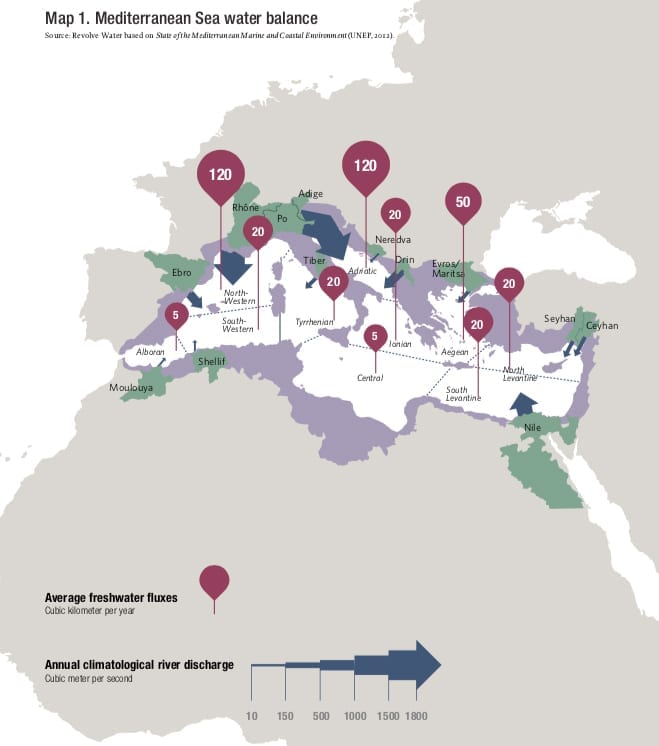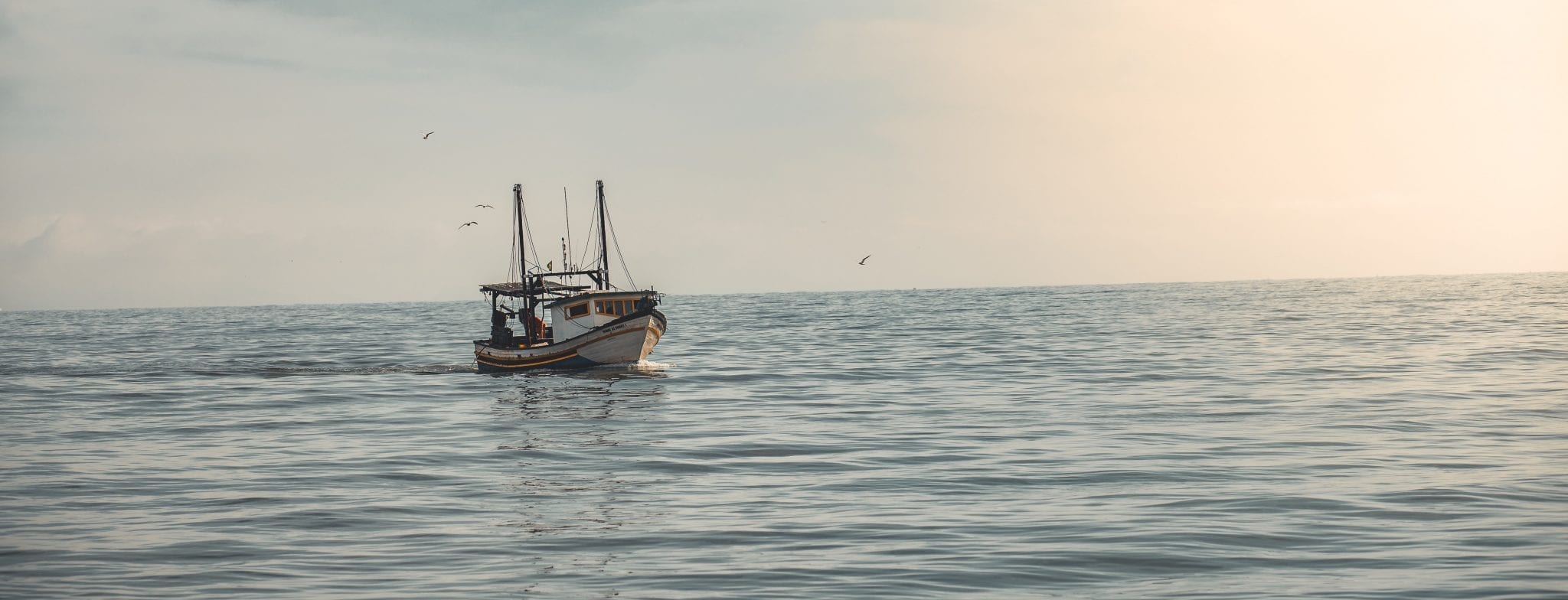Mare Nostrum
The history and culture of the Mediterranean region are intimately linked to water. To ensure a sustainable future and provide for its growing population, the region must prioritize its water and energy management.
While the story of the Mediterranean as a cradle of civilization has been told many times, its water history has remained largely unexplored despite its importance. The history and culture of the region are closely linked to water, and the health of the sea is strongly dependent on the health of the rivers flowing into it. In addition, the interlinkages with energy are today becoming increasingly important.
Water defines the Mediterranean region in many ways. The Mediterranean Sea has been important for travel and trade for centuries, particularly for connecting otherwise distant cultures, north to south, east to west, and between the three continents which surround it: Europe, Asia and Africa. The sea is an important source of food. Inhabited islands, some of them nations in their own right, are defined by their physical isolation and historical dependence on seaborne trade. Local climate, which varies significantly across the region, is strongly influenced by how much water falls from the sky and how quickly it evaporates.
In many areas, the availability of water is a constant and growing concern due to the demands of growing populations and wealth. In the driest areas, traditional technology has made a critical contribution to water supply for centuries.
An example is the qanat system of underground water channels. Originating in ancient Persia, qanats (known elsewhere as falaj, khettara and foggara) were introduced to the Mediterranean region, first by the westward extension of the Persian empire and later through Arabic and Moorish influence across North Africa and southern Spain, from where the concept was transported to South America. They also appeared in Sicily and Cyprus. Qanatswere important for both drinking water and agriculture.
New technologies such as desalination are now becoming essential in some areas, but with the disadvantage of a high energy demand and a by-product of brine (see p. 50). Traditional technologies can, however, still play an essential role in sustainable water use, and should not be entirely abandoned.
The Mediterranean Sea has been important for travel and trade for centuries, connecting otherwise distant cultures in Europe, Asia and Africa.
The region’s rivers
The Mediterranean Sea covers an area of 2.6 million km2. The 23 countries and three continents that border it (including island states) form a total coastline of around 46,000 km. Because the sea has only narrow connections to other seas and oceans, the inflowing rivers make a significant contribution to its condition, bringing fresh water, nutrients and pollution. Over many centuries, the sediment carried by these rivers has shaped the sea, forming great deltas at the mouths of the larger rivers, such as the Nile and the Rhône. The Mediterranean Sea has an average depth of 1,500 m, with the deepest point at 5,267 m in the Ionian Sea south of Greece.
The total drainage basin of all rivers is twice as large as the Mediterranean Sea itself, at around 5 million km2. The largest individual river basin is that of the Nile (representing more than half of the total basin at 3.2 million km2), stretching 6,650 km southwards to Lake Victoria on the Equator. Despite the size of its basin, the Nile is not the biggest supplier of fresh water, with most of its flow used by populations along its route or lost to evaporation, more so since the construction of the Aswan Dam in Egypt. The Nile now supplies only 3% (15 km3/yr) of freshwater flows into the Mediterranean. Most fresh water flowing into the sea comes from the more water-abundant climate of Europe, with the largest single flow from the Rhône of France, providing 12% of the total (54 km3/yr).
A fragile balance
The total flow of water into the Mediterranean Sea, from all rivers and the Black Sea, is insufficient to maintain its water level. The evaporation rate is higher than the total of river inflows and direct rainfall combined. Without any other inflow, the water level would fall at a rate of nearly 1 m/yr. What stops this is a net inflow from the Atlantic Ocean through the Straits of Gibraltar.
In fact, the Mediterranean Sea did dry out about 6 million years ago when geological movements closed the Atlantic opening, with the sea slowly shrinking over thousands of years. This resulted in great salt deposits more than 1 km thick, a modern legacy of which includes the salt mines of Sicily. About 5.5 million years ago, the gap started to open again, with some studies claiming a rapid refilling that created a waterfall 1,000 times larger than Niagara Falls.
The approximate water balance of the Mediterranean Sea is shown in Map 1. With no outflow, there is no ‘flushing through’ of the water. Instead, the water is slowly replaced through the process of evaporation and inflow, taking about 100 years to be completely replaced. With evaporation as the main outflow, pollutants accumulate, and the sea is slowly becoming more saline. It is currently about 6% more salty than the Atlantic.

The natural rate of water replacement is already slow, but it could be slowing further due to human and climatic impacts. For example, it is estimated that freshwater flows into the sea decreased by about 20% between 1960 and 2000. This is partly ascribed to a drop in rainfall, but also to the construction of dams and the increased use of water from the inflowing rivers. For example, the outflow of Spain’s Ebro River has dropped by 50% since the 1950s as a result of increased human use.
The natural rate of water replacement in the Mediterranean is already slow, but it could be slowing further due to human and climatic impacts.

Human impacts
Humans have a significant impact on the waters of the Mediterranean Sea. The total population of Mediterranean countries increased from 276 million in 1970 to nearly 500 million today. For most countries in the region, populations are concentrated along the coast. There are many human pressures, including the expanding urban populations, the growing impact of agriculture, industry, shipping and tourism, waste and wastewater disposal, fishing and water use.
The Mediterranean Basin is the largest tourist destination in the world, attracting around a third of all global tourists (310 million out of 1 billion). Of course, this is good for the economy, especially of less- developed regions, but it also applies significant pressures on the natural environment and demand for resources, including water and energy, and an increase in wastewater and general waste. To add to the pressure, tourism is mostly concentrated during the summer months when rainfall and river flows are lowest.
The Mediterranean is one of the busiest regions in the world for marine transport and shipping activities, which place considerable pressure on the marine and coastal environment. More than 75% of global maritime traffic transits through the sea, with the transport of oil and gas from the Black Sea ports and the Arabian Gulf playing a key role. The environmental impacts from shipping include accidental spillages, paint biocides, accidental transport of invasive species, physical striking of sea animals and underwater noise. In fact, the impact on wildlife of human-generated marine noise from many sources is a growing environmental concern. Despite a ban on sea-dumping, illegal waste disposal continues. There are also impacts from ports and their associated infrastructure on land.
The health of the Mediterranean Sea is strongly dependent on the health of the rivers flowing into it.
Fish stocks
Fishery is also an important industry and a key component of the region’s cultural identity. The pressure on fish stocks is high, with more than 65% of commercial stocks considered to be overfished. Some species, like the Atlantic blue-fin tuna, are endangered. Despite these major concerns, there is a view that stocks are more resilient than might be expected, helped by a high diversity of refuge and spawning zones, and the high proportion of small-scale commercial operators, representing 85% of the fishing fleet. Many boats are not even motorized, as in Tunisia where 70% of the 14,000 fishing boats are non-motorized. The pressures are also offset by a ban on trawling at more than 1,000 m depth, and the fact that two thirds of demand for fish is sourced from outside the region. However, the state of fish stocks and threatened species remains a major concern, requiring monitoring, management and political cooperation.

Energy
Energy resources are clearly important to support the growing population and wealth of the region, also providing direct economic benefits. But energy resources are also a source of environmental damage and pollution. The oil and gas industry is significant in the region, dominantly in Libya, Algeria and Egypt. Smaller-scale producers are Greece, Italy, Cyprus, Israel, Jordan and Turkey. Exploration of new resources is active both onshore and offshore, with recent large discoveries in the eastern Mediterranean, such as the Leviathan gas field off the coasts of Israel, Palestine (Gaza) and Lebanon. There is also the potential for shale gas development in North Africa, principally in Algeria and Libya.
The region has significant potential for renewable energy. Hydropower is already important on many of the region’s rivers. For example, on the Nile in Egypt with the Aswan Dam, the Rhône, with 19 hydropower stations, the Ebro in Spain and the River Po in Italy. The potential of solar and wind power remains highly underused, but there are some positive developments. Spain is one of the most successful countries for wind power, being fifth in the world for wind-power capacity, and the largest around the Mediterranean – although its growth rate has slowed. The prospect of providing a large part of Europe’s energy from solar power plants in the North African deserts remains a dream, an example being the now much-restricted DESERTEC project. One of its successes is the recent installation of the world’s largest solar power plant near the Moroccan town of Ouarzazate, with a potential to supply 1.1 million people. For now, this will, however, be used for domestic supply.
As the Mediterranean is an enclosed non-tidal sea, tidal and wave power have limited potential. However, large flows of water through the Straits of Gibraltar, in both directions as the Atlantic tide rises and falls, are being researched as a potential energy source.
There are various interdependencies between water and energy in the region, both positive and negative. The majority of energy supply to the region remains fossil fuels, both imported and sourced from within the region. While fossil fuels have a growing negative image (principally due to the climate change association), they will remain an important contribution to affordable energy for some time, especially in developing economies to the east and south of the region. A negative link comes from the potential for pollution, from oil tankers, and associated industrial activities. A positive link is that fossil fuels, so far, remain the most viable energy source for desalination to provide essential drinking water in water-scarce areas, such as Malta. Energy is also essential for the pumping and treatment of more conventional water supplies, for drinking water and for irrigation.
A paradox is that the same natural energy resource which creates conditions of water scarcity, the sun, also creates the main opportunities for renewable energy, from solar power, and wind (itself driven by temperature differences across the region).
As the Mediterranean populations and economies expand, there is a growing demand for water and energy, and their use and development are closely interlinked. A sustainable and successful future for the region is dependent on careful and sensitive management of the two most precious natural resources and achieving the optimum balance between supporting the needs of the population and economy, while improving, protecting and investing in the environment.